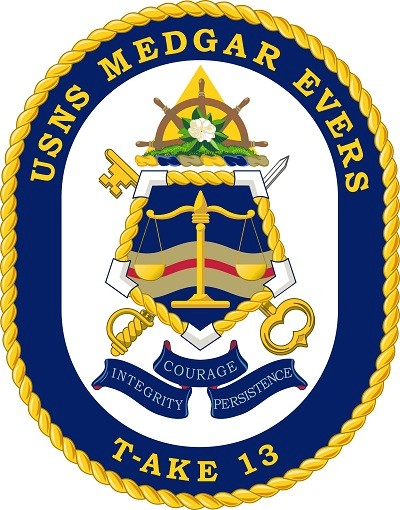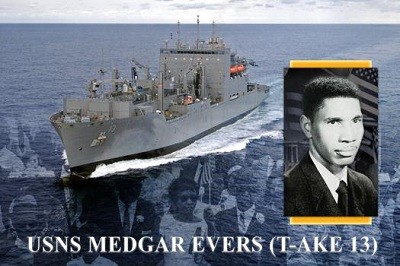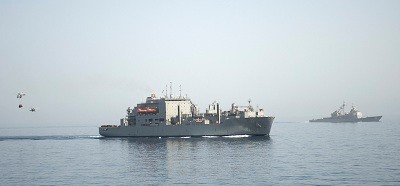Medgar Evers (T-AKE-13)
2012-
Medgar Evers, born in Decatur, Miss., on 2 July 1925, to James and Jesse Evers, a farmer and sawmill worker and his wife, was the third of five children and left high school at the age of 17 to enlist in the U.S. Army in 1943. Evers landed in Normandy, France, in June 1944 following the D-Day landings and fought across France and Germany. He received his discharge as a technician fifth grade [sergeant] from the Quartermaster Corps in 1946.
Evers earned honors while attending Alcorn College, Miss., and married his classmate, Myrlie Beasley, on 24 December 1951, a union that eventually produced three children: Darrell Kenyatta, Reena Denise, and James Van Dyke. Evers graduated with a bachelor of arts the following year, and then worked as an insurance agent in nearby Mound Bayou. He began to participate in meetings of the Regional Council of Negro Leadership (RCNL) that enabled him to gain experience in civil rights activism. One of his tasks involved distributing bumper stickers that read, “Don’t Buy Gas Where You Can’t Use the Restroom.”
Following Brown v. Board of Education 347 US 483, the Supreme Court’s landmark decision that declared racial segregation in public schools unconstitutional, Evers applied for admission to the University of Mississippi Law School in 1954. The school denied his application, however, claiming that he failed to provide the required letters of recommendation. Evers sought assistance from the National Association for the Advancement of Colored People (NAACP), and his dignity and perseverance in his quest impressed Emmett J. Stringer, the NAACP’s Mississippi State Conference Leader, who hired him as their first field secretary of state.
During the following summer, however, a group of white men abducted, and murdered, 14-year-old Emmett Till, alleging that he had made advances toward Carolyn Bryant, a 21-year-old white, and married, owner of a small grocery store, while Till had visited relatives in Money, Miss. (25–28 August 1955). His mother, Mamie T. Bradley, held an open casket funeral in Chicago, Ill., that raised public awareness of the crime. The NAACP, fearing that local police authorities might not pursue the investigation vigorously, launched their own investigation. Evers and two other field workers, Ruby Hurley and Amzie Moore, interviewed witnesses, gathered evidence, persuaded several people to give testimony, placed them in protective custody, and then spirited them out of the area after they had testified. The all-white jury, however, deliberating for barely an hour, delivered a verdict of “not guilty.”
Following that experience, the Supreme Court finally ruled in favor of Evers concerning his admittance to the University of Mississippi in 1962. Evers and a protective entourage of civil rights activists accompanied James H. Meredith, a man of African-American and Choctaw Native American heritage, when Meredith arrived at the university’s Oxford, Miss., campus on 1 October 1962. Their appearance sparked riots that prompted President John F. Kennedy to deploy U.S. marshals, soldiers, and national guardsmen to restore order and protect the students. Two people died, and more than 200 sustained injuries, in the unrest. Ultimately, Meredith graduated with a degree in political science (having already accumulated credits elsewhere prior to his matriculation at the University of Mississippi) on 18 August 1963. Evers’s participation in this and additional civil rights activism, however, enraged white segregationists.
Someone threw a Molotov cocktail into the carport of Evers’s home at 2332 Margaret Walker Alexander Drive in Jackson, Miss., on 28 May 1963. On 7 June, a car nearly ran him down as he emerged from the NAACP office in Jackson. On the morning of 12 June 1963, Evers attended a meeting with NAACP attorneys. Upon his return home, he stepped from his car carrying NAACP T-shirts that read “Jim Crow Must Go,” when a bullet, apparently fired from an Enfield 1917 rifle, struck him in the back. He died less than an hour later. Evers was buried with full military honors at Arlington (Va.) National Cemetery.
The police arrested Bryon De La Beckwith, a fertilizer salesman and a member of the White Citizen’s Council (and later the Ku Klux Klan), for Evers’s murder, on 23 June 1963. Two different, but all-white, juries failed to convict Beckwith the following year, claiming deadlock. Evidence subsequently came to light, however, that enabled a racially-mixed jury to convict Beckwith and sentence him to life in prison, on 5 February 1994. He died at the University of Mississippi Medical Center in Jackson, on 21 January 2001.
Evers’s widow continued the civil rights activism in which her late husband had been prominent, and delivered the invocation at the second inauguration of President Barack Obama on 21 January 2013.
(T-AKE-13: displacement 42,528; length 689; beam 106'; draft 30'; speed 20 knots; complement 197; armament up to 6 .50 caliber or 7.62 millimeter machine guns and two Sikorsky MH-60S Knighthawks or two Eurocopter (Aérospatiale) AS332 Super Pumas; class Lewis and Clark)
Medgar Evers (T-AKE-13) was laid down on 26 October 2010 at San Diego, Calif., by General Dynamics National Steel and Shipbuilding Co.; launched on 29 October 2011; sponsored by Mrs. Myrlie Evers-Williams, widow of the late Medgar Evers; and was placed in service with the Military Sealift Command on 24 April 2012.

Shield
Dark blue and gold are the colors traditionally used by the Navy. The shape of a pentagon alludes to the Pentagon and the Department of Defense. The scale (balance in equilibrium) is balanced to show equality. The buff fess wavy represents the Mississippi River (the “Big Muddy”), from which the State of Mississippi takes its name, and also alludes to the supply and delivery of cargo that the ship will undertake. Buff also is a color associated with the Army’s Quartermaster Corps (in which Evers served), a foundation of logistics. Decatur, Miss., is where Medgar Evers was born. The addition of the red barrulet references “A Mighty Stream” and flows behind justice.
Crest
The delta represents the Mississippi Delta, a rich fertile area, and here is also represented as an equilateral triangle to suggest equality and civil rights. The ship’s wheel is a Navy symbol but is used here to also represent the position of the Quartermaster. The magnolia, representing perseverance, is abundant in Mississippi and is the official State flower.
Supporters
The sword and key are traditional symbols depicting control of military supplies, and are replicated here to represent Evers’ service as a soldier of the Quartermaster Corps.


Medgar Evers emergency sortied in advance of Hurricane Sandy from Norfolk, Va. (late October–early November 2012).
Detailed history under construction.
Mark L. Evans
23 January 2014


